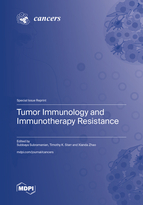Tumor Immunology and Immunotherapy Resistance
A special issue of Cancers (ISSN 2072-6694). This special issue belongs to the section "Cancer Immunology and Immunotherapy".
Deadline for manuscript submissions: closed (15 December 2022) | Viewed by 29673
Special Issue Editors
Interests: colorectal cancer; tumor immunology; T cells; immune cells; microbiome
Special Issues, Collections and Topics in MDPI journals
Interests: cancer driver genes; mouse models of cancer; immunology
Interests: gastrointestinal cancers; cancer immunology; immune checkpoint inhibitors
Special Issues, Collections and Topics in MDPI journals
Special Issue Information
Dear Colleagues,
Over the last decade, there has been an increasing understanding of molecular mechanisms that regulate anti-tumor immune responses and an exponential increase in the use of novel cancer immunotherapies in various cancer types. Despite the demonstrated success of tumor immunotherapy, most patients do not respond, and there is also a development of resistance mechanisms in patients who initially respond to immunotherapies. The scope of this Special Issue aims to cover current knowledge, cutting-edge technologies, and prospects in tumor immunology and immunotherapies. We hope that the research and review articles in this Special Issue will provide valuable references for developing next-generation cancer immunotherapies.
Dr. Subbaya Subramanian
Dr. Timothy K. Starr
Dr. Xianda Zhao
Guest Editors
Manuscript Submission Information
Manuscripts should be submitted online at www.mdpi.com by registering and logging in to this website. Once you are registered, click here to go to the submission form. Manuscripts can be submitted until the deadline. All submissions that pass pre-check are peer-reviewed. Accepted papers will be published continuously in the journal (as soon as accepted) and will be listed together on the special issue website. Research articles, review articles as well as short communications are invited. For planned papers, a title and short abstract (about 100 words) can be sent to the Editorial Office for announcement on this website.
Submitted manuscripts should not have been published previously, nor be under consideration for publication elsewhere (except conference proceedings papers). All manuscripts are thoroughly refereed through a single-blind peer-review process. A guide for authors and other relevant information for submission of manuscripts is available on the Instructions for Authors page. Cancers is an international peer-reviewed open access semimonthly journal published by MDPI.
Please visit the Instructions for Authors page before submitting a manuscript. The Article Processing Charge (APC) for publication in this open access journal is 2900 CHF (Swiss Francs). Submitted papers should be well formatted and use good English. Authors may use MDPI's English editing service prior to publication or during author revisions.
Keywords
- immunotherapy
- tumor immunology
- immune checkpoint inhibition
- immune cells
- immunotherapy resistance
- immune evasion








